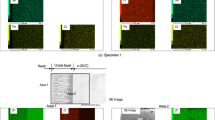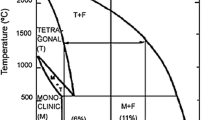Abstract
The radiation-stimulated structural phase transformations can significantly affect the processes influencing on the structural materials operation under radiation and high temperatures conditions. These processes lower reliability and service life of shells and covers thus reducing the times of safe operation of nuclear reactors. Therefore the search for the way and technologies directed to the increase in reliability and durability of fuel element (tvels) shells and thermal converter covers is a special issue of the present day. The purpose of the present paper is to give the description of the performed series of experiments on carbidization of the zirconium substrate surface. Such carbidization has been conducted through the carbon nanostructures dissolution in the matrix volume under various conditions of heat treatment. Metallic and nonmetallic catalysts have been used to synthesize carbon nanostructures on the zirconium alloys surfaces. The surface of test specimens of thermal fuel elements (tvels) has been subjected to grinding and also to the electrolytic polishing in acid-water solution for taking the strain hardening. Carbon nanostructures have been synthesized on the substrate surfaces by the method of acetylene pyrolysis. Nickel nanoparticles deposited on the substrate by cladding have been used as a metallic catalyst. Synthesis of carbon nanostructures on such catalysts allows the formation of uniform layer of carbon nanotubes on the sample surface. The microhardness has been measured for the synthesized specimens with nanotubes on the zirconium substrate cladded with nickel and compared with initial samples. The study has revealed that the microhardness of treated specimens increases, resulting in the hardening of tvel covers by carbidization and in doing so authors have found a way to the rise of reliability and durability of tvel shells and thermal converter covers hardenable by heat-treatment.
Access this chapter
Tax calculation will be finalised at checkout
Purchases are for personal use only
Similar content being viewed by others
References
Iseki M, Uchida K, Kirihara T (1977) Electron radiation damage of electrode steel in a high voltage electron microscope. In: Proceedings of the 5th international conference on high voltage electron microscopy. Kyoto pp 585–588
Boulanger L (1977) Precipitation ordounee de carbures dans des aciers toadies. J Nucl Mater 64(1/2):176–182
Stanley JT, Hadricson LE (1979) Ferrit formation in neutron-irradiated austeritic stainless steel. J Nucl Mater 80(1):69–78
Williams TN, Titchmarsh JM (1979) The occurrence of silicon-rich phase of the M6C type in neutron-irradiated FV548 steel. J Nucl Mater 87(2–3):398–400
Maradhi M (1978) Untersuchungen an neutronenbestralten kupferdotieren Eisenpoben mit Hilfe der Neutronenkleinwinkelstreuung. Ges Kernenergieverwert Schiffhau schi ffahrt E40:159
Chambered A, Laugier J, Penisson JM (1979) Electron irradiation effects on iron-nikel invar alloys. J Magn Magn Mater 10(2/3):139–144
Bian Z, Wang RJ, Wang WH, Zhang T, Inoue A (2004) Carbon-nanotube-reinforced Zr-based bulk metallic glasscomposites and their properties. Adv Funct Mater 14(1):59–63
Dubovtsev IA, Maslov VI et al (1980) Effect of ionic irradiation on Fe-Ni and Fe-Si alloys. Izv Sev Kavk Nauch Cent Vyssh Shkoly Estestv nauki 2:33–37
Huang L, Lau SP, Zhang YB, Tay BK, Fu YQ (2004) The synthesis of carbon nanotubes and zirconium carbide composite films on a glass substrate. Nanotechnology 15(5):663
Lee WJ, Smyrl WH (2005) Zirconium oxide nanotubes synthesis via direct electrochemical anodization. Electrochem Solid State Lett 8(3):B7–B9
Acknowledgment
The work has been done under financial support of STCU grant 4012.
Author information
Authors and Affiliations
Corresponding author
Editor information
Editors and Affiliations
Rights and permissions
Copyright information
© 2011 Springer Science+Business Media B.V.
About this paper
Cite this paper
Bogolepov, V.A. et al. (2011). Synthesis of Carbon Nanotubes on Zirconium Alloys Surface. In: Zaginaichenko, S., Schur, D., Skorokhod, V., Veziroglu, A., İbrahimoğlu, B. (eds) Carbon Nanomaterials in Clean Energy Hydrogen Systems - II. NATO Science for Peace and Security Series C: Environmental Security, vol 2. Springer, Dordrecht. https://doi.org/10.1007/978-94-007-0899-0_13
Download citation
DOI: https://doi.org/10.1007/978-94-007-0899-0_13
Published:
Publisher Name: Springer, Dordrecht
Print ISBN: 978-94-007-0898-3
Online ISBN: 978-94-007-0899-0
eBook Packages: Chemistry and Materials ScienceChemistry and Material Science (R0)




